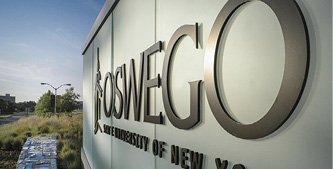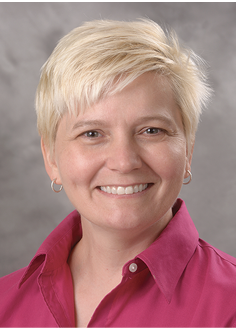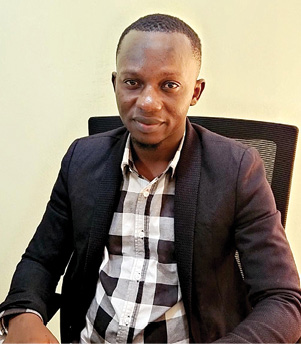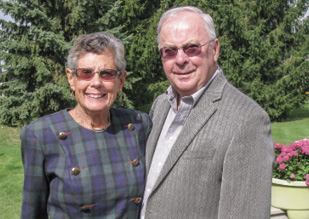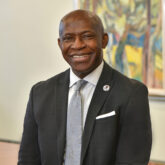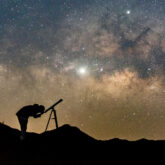Richard Woolley ’89 opened the doors to Weathered Vineyards near Allentown, Pa., with his wife of 30 years, Dana Master Woolley ’87, in 2014.
The winemaker shared his experiences – and some memories of SUNY Oswego – in an interview in 2016.
How did you and Dana meet?
Richard Woolley: Dana and I met in Oswego at a Sigma Tau Chi fraternity party in late September 1986. Long story short, we ended up later that evening at The Woodshed, then had our first kiss on the corner in front of Bucklands. From there, it’s been an amazing 30 years.
How did you get involved in winemaking?
Richard Woolley: Our interest in winemaking grew out of a passion for seeking out wineries all around the United States. Of course in the early years, just after college, what could a young couple with no kids or a boat do for fun in Central New York that did not cost an arm and a leg? Go camping in the Finger Lakes region and visit wineries, which in those days rarely ever charged a tasting fee. Camping was $6 a night and free wine – it was pretty much a winning combination!
That was the start, but before too many years passed, my job as a meteorologist found us chasing a weather job as a civilian contractor for the U.S. Army in Utah. I was monitoring the weather around a chemical weapons storage and disposal site. Not much wine there, but one heck of a world removed from Oswego! However, they do have lake effect snow there off the Great Salt Lake, and, of course, purely by accident we moved into one of the areas that frequently got buried.
Another job change brought us back east to Pennsylvania, and one Christmas Dana bought me a wine making kit. So one day in January or February of 2001 I started the kit by following the instructions and making my first wine. I bottled it all up nice and, proud of myself, I placed it in the cellar to age, promising not to drink it for at least six months. Well as luck would have it, another job change came to go out west again and do weather forecasting for wildland fires in the Southwest for the National Park Service. As the moving truck arrived the driver informed us that the wine couldn’t go. Who knew that moving companies will not transport wine?
I was already in Albuquerque, so Dana approached a neighbor/friend and left them a parting gift of two cases of wine and told them, “This is Rich’s first try at it so don’t be too surprised if it’s not very good.”
Almost a year passed and one day we got a call from the old neighbor who was just finishing off the wine we gave them. She thanked us, saying it was some of the best wine they ever had. I shucked it off as a fluke. About the same time we figured out that there were wineries in New Mexico, quite a few, but instead of going to visit each one, they all came to Albuquerque or Santa Fe once a year and for a few bucks you could taste them all without having to drive. Score!
Then it was time for another job change. This time I was the boss of the Great Basin Fire Weather Program in Reno, Nevada. There are no wineries or vineyards in Reno, but we soon discovered that a short drive over the hill (Sierra Nevadas) put us right in the middle of spectacularly beautiful Old Vine Zinfandel country southeast of Sacramento in the foothills. Let’s just say we went over the hill an awful lot those years, tasting new wines, ports, champagnes and different styles of the same wine. Tastings were still mostly free; we were, after all, nowhere near Napa and Sonoma.
Another job change brought us back to the East Coast and into the Allentown area of Pennsylvania. No wine here, we thought. But it turns out, that’s not quite true. There were wineries making mostly sweet “eastern” style wines. One day we found Blair Vineyards driving home from a trip someplace. We saw the sign, and, of course, Dana suggested we stop. Blair Vineyards made wines like those that we remembered from the west: dry, full of flavor and body with subtle hints of fruit and a complexity that is missing in most eastern wines. It was during one of those lazy weekend days over a Pinot Noir that we discussed someday owning a winery might be a great second career.
We had become good friends with Rich Blair, the owner of Blair Vineyards, and told him of our dreams, but like anyone who actually owns a winery you hear that a lot knowing it will never happen.
All along I was making wine each fall and I then discovered I could also make wine in the spring with grapes from Chile. Before long, we had a fully stocked wine cellar, and I was giving some away to the neighbors.
At about this time our oldest was heading off to college and the youngest was about to hit high school and we began to look at our future, wondering. It wouldn’t be long before we were empty nesters. We took a trip up to the Finger Lakes for the first time in 20 years for a long weekend of camping, wine tasting (we had our own designated driver), stopping at our favorite wineries from so long ago and some new ones, too. We saw the results of what 20 years did to the wine industry of the Finger Lakes; it had grown up from family-run farm operations to big time successful businesses. Dana and I knew immediately that eastern Pennsylvania was just like the Finger Lakes 20 years ago. We went home and began searching for land, and after almost a year of searching we bought 13 acres and became farmers. It was about that same time we looked at each other and decided it was time to go all in and take a once in a lifetime chance. We sold the house we had been living in, cashed in some minor stock holdings and other assets and began planning our new life at the vineyard.
Like any good farmer/winery owner we planted 3,000 vines first, then got a tractor, then built a barn and lived out of boxes in a tiny apartment for the winter of 2013-2014. Finally in the spring after planning all winter we began house construction, thinking, “Hey, what could go wrong?” That was the year real winters decided to return to the eastern U.S., and we hit -15F one night. Bye-bye little grape vines. Nearly 2/3rds died over that winter. All that work was gone in one night.
We planned to buy grapes anyway so the winery dream lived on, and with the help of the folks at Blair Vineyards, we produced about 450 cases of wine in 2014 and got ready to open the winery — if only we could get the electricity turned on! Finally by late September 2014 we got electricity to the winery and did a very soft opening just to kick the tires. A few people came by to see, but they were mostly neighbors. We had announced our official grand opening a few weeks later. The local paper did a little story on us and shot a few pictures, but little did we realize what they would do for us, we became the feature story that weekend.
Grand opening arrived Columbus Day Weekend, and after a brief prayer the night before hoping that someone would show up, we were delighted to see spectacular weather. Before we knew it there were literally hundreds of people at our door both days and Weathered Vineyards was born!
How does meteorology play into owning/operating a winery?
Richard Woolley: For us, the weather is crucial for every aspect. Obviously, the farming is weather dependent: when to spray, prune, pull leaves, harvest, etc. are all driven by the weather and what the weather forecast tells us.
Little did we know how important weather is with everything else, too. Are the customers going to show up? Will the musical act have good weather to be outside? The weather even impacts winemaking decisions. For example, we need cold weather during the winter to help stabilize the wines; since we are small, we don’t use refrigeration like they do in California. We let Mother Nature work for us. A couple weeks in the 20s and presto, it’s done for free.
Is this a family operation?
Richard Woolley: This is a first generation family-owned winery. Most wineries usually are when they first get started, and if successful the second generation and beyond reap the greatest rewards. I like to joke that the winery is my nights, weekends and holiday job to go along with my regular day job running a private long range weather forecasting company.
Can you shed light on a typical day running a winery?
Richard Woolley: A typical day is tough to describe, for it’s never the same. Some days it’s doing chemistry testing of the wines as they age, checking sulfites, acidity, pH, etc. One day I may be pumping barrels out, washing the barrel and pumping the wine back in. Another day may be bottling the wine, yet another involves working in the vineyard spraying.
More fun in the vineyard may include suckering the vines, leaf pulling, shoot positioning, raising the catch wires, or just simply mowing the grass, which everyone seems to want to do (and why not? The tractor does have an air conditioned cab and radio and a drink holder!). Late in the year it;s all about protecting the fruit from birds, my most hated enemy; and deer. They seem to love a big helping of grapes the day before we pick. My neighbors think I am nuts when I go running out of the house screaming like a madman at the birds to scare them away, but trust me we can have a flock of thousands show up.
Other days at the winery may involve setting up tables or seating for events, stocking the shelves, because running a winery for our guests is really all about “winertainment.” But sometimes there are just those nice days when the weather is beautiful with a few clouds and a breeze, not too hot or cold, and you can sit back enjoy a glass of wine and watch the weather go by in silence.
How did Oswego prepare you to take on an operation that runs the gamut from agricultural to scientific, to marketing to distribution and sales?
Richard Woolley: This is where Dana and I split duties. My classes at Oswego were obviously useful for the technical nuts and bolts weather part and the chemistry. But there is also a more holistic part of it as well, which allows me to see a bigger picture sometimes. It helps to be familiar with the difference between an advection freeze versus a radiation frost event and how it applies to grape growing. Things such as, it’s coldest before the sunrise, or that during the growing season a southeast facing slope will receive direct morning sunshine but more indirect late afternoon sunshine resulting in more growing degree days while at the same time increasing the temperature and lowering humidity quickly in the morning but at the same time keeping the grapes from boiling in the late hot afternoon sun. I can understand how the equipment works and why it reads or calculates what it does and at the same time I can tell when a reading doesn’t make any sense.
Dana, on the other hand, is the marketing and sales person, which is where her communication degree comes in handy. Event planning is another one of Dana’s skills. She is the one who designed our logo and label design for the bottles. It was her suggestion to do something unconventional both in shape and color and it works. At least several times a month someone comes into the winery and comments about how they love the label design and the paint colors in the winery — dark purple on one wall and saffron yellow on the other walls and ceiling.
We have come up with some very unique events that we are now seeing being held at other local wineries. Coming up with new and interesting events is vital to us growing as well as connecting with our current customers and attracting new customers on social media and on our website. Dana maintains the website, Facebook and other social media tools.
Back in your Oswego days, what was your drink of choice? What is it now?
Richard Woolley: Beer for me, heck we met over a keg. But beer fills you up and liquor gets you drunk so my tastes evolved to wine. First, it was sweet white wines, and now it’s dry, big red wines. My favorite currently is Cabernet Franc.
What are the top five things people should consider when selecting wine?
Richard Woolley:
What is the wine’s purpose? (To drink by itself or to pair with food?)
Who made the wine? (Every winery has a style.)
What is the age of the wine? (Cabernet Sauvignon should be at least 5 years old before consuming. Riesling maybe less than a year.)
What is the price? (Most people unless they are real wine snobs cannot tell the difference between a $30 bottle of wine and $100. However, wine which is less than $10 probably is mass produced and often employs ‘shortcuts’ to get to the finished product.)
The taste! (Have you ever had this wine before and did you like it? Because in the end it doesn’t matter how much it costs, what you serve it with, who made it or the price if you end up pouring it down the drain!)
Join the Woolleys on their vineyard adventures at www.weatheredvineyards.com. They are also on social media at www.facebook.com/weatheredvineyards/ and https://twitter.com/weatheredvines, and hold events to share their wines with the public.
You might also like
More from Alumni Profiles
Astrophysicist, Yale Professor Credits Oswego with Setting His Course for Stellar Career
Astrophysicist, Yale Professor Credits Oswego with Setting His Course for Stellar Career Earl Bellinger ’12 is one stellar guy. A quick review …
BHI Alumnus from Liberia Gains World of Experience
BHI Alumnus from Liberia Gains World of Experience Otis Gbala M’23 became the first SUNY Oswego graduate who studied from Liberia …
Couple’s Loyal Support for Oswego Spans Five Decades
Couple’s Loyal Support for Oswego Spans Five Decades Marilynn “Lynn” Nagy Farrar ’61 and Neil Farrar cherish their memories of Oswego …







